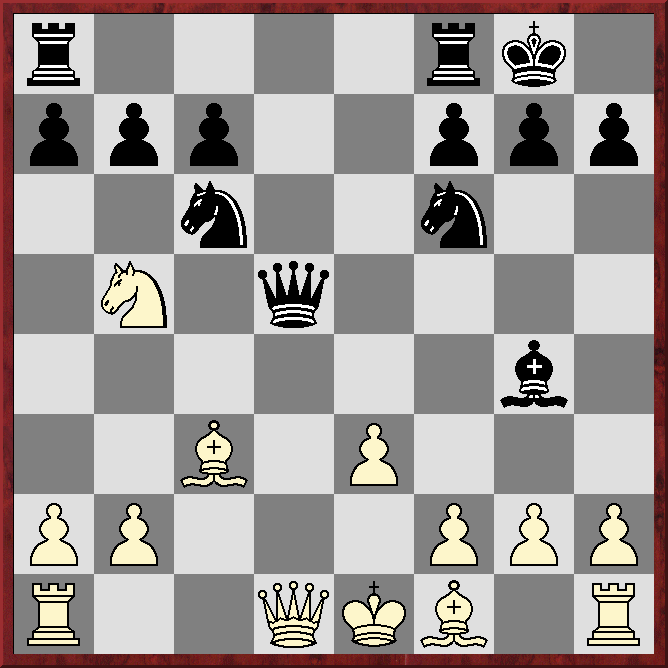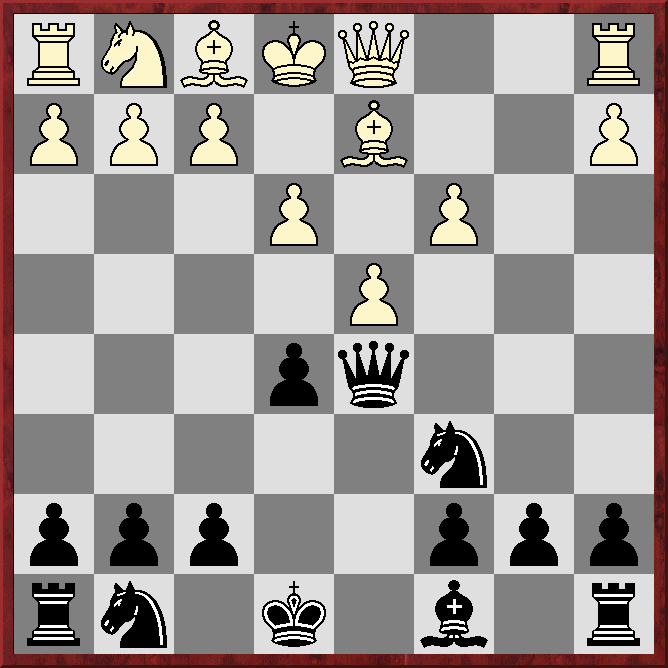The full game can be seen at ML 6 but here I want to look in some depth at the opening.
After 1.d4 d5 2.c4 Nc6 my opponent played 3.cxd5, of which there are 2,795 examples in ChessBase's 2022 Mega database.
It is less popular than 3.Nf3 and 3.Nc3 but has been played by many famous names, including Wilhelm Steinitz, Frank Marshall, Wolfgang Uhlmann, Garry Kasparov, Jaan Ehlvest, Alexander Beliavsky, Joël Lautier, Veselin Topalov, Boris Avrukh, Jeroen Piket, Viktor Korchnoi, Loek van Wely and the current world No2 Alireza Firouzja.
In The Chigorin Defence According To Morozevich by Alexander Morozevich and Vladimir Barsky (New In Chess 2007) 3.cxd5 is described as an "attempt by White to immediately punish his opponent for his violation of the strategic rules. Contrary to Steinitz's positional teaching, Black [has] not supported[ed] his central d5 pawn. The immediate exchange on d5 forces the black queen into the thick of things, where it may come under attack by the opposing minor pieces and pawns. But [after 3...Qxd5] ... the d4 pawn is under attack, and White has to spend a tempo on defending it."
In the early days of the Chigorin White usually met 3...Qxd5 with 4.Nf3, and that seems to have remained the case until at least the mid-1990s.
But today 4.e3 is much more popular, there being 1,880 examples in Mega22 compared with 883 for 4.Nf3, and in the opinion of Valery Bronznik in The Chigorin Defence (Kania 2005) it "turns out to be more dangerous."
Bronznik gives 4...e5 an exclamation mark, although it is hard to come up with a reasonable alternative.
Following 5.Nc3 Bb4 White can choose how to win the bishop-pair.
*****
*****
*****
*****
There are just 238 examples of 6.a3!? in Mega22 but it deserves serious consideration, not least because it is the choice of Stockfish14.1 and Komodo12.1.1.
There are just 238 examples of 6.a3!? in Mega22 but it deserves serious consideration, not least because it is the choice of Stockfish14.1 and Komodo12.1.1.
After the forced 6...Bxc3+ 7.bxc3 the engines reckon White has at least a slight edge, but Morozevich/Barsky state: "The bishop on c1 is passive and after the natural 7...Nf6 Black completes his development in normal fashion and obtains sufficient counterchances."
Bronznik says of 6.a3!?: "Sometimes in the variation 6.Bd2 Bxc3 7.bxc3 the queen's bishop goes back to c1 and then to a3. That is why [with 6.a3!?] White does not hurry with the development of the c1 bishop, but wants to bring it later straight to a3."
After 7...Nf6 play usually continues 8.c4 Qd6 (Vassily Ivanchuk and Vasilios Kotronias have tried the rare 8...Qd8!?) 9.d5 Ne7 10.a4, when Pavel Eljanov (2751) - Alexander Moiseenko (2669), World Cup Rapid (Odessa, Ukraine) 2010, saw 10...0-0 (10...Qb4+!?) 11.Ba3 Qd8 (definitely better than a 2123's 11...c6??) 12.Ne2 c6 13.Nc3 cxd5 14.cxd5, which the engines reckon is quite a bit better for White, although the game was drawn in 63 moves.
There are 1,932 examples of 6.Bd2 in Mega22, with Black nearly always replying 6...Bxc3, after which White again has a choice.
The recapture 7.Bxc3 is "interesting and dangerous," according to Bronznik, while Morozevich/Barsky write: "White wants ... to clear the centre immediately and exploit the power of his bishops. Black's trumps remain the same: a slight lead in development and the active position of his queen in the centre."
Following 7...exd4 the black queen is pinned, so White can reply 8.Ne2!?, when play usually continues 8...Nf6 9.Nxd4 0-0.
Bronznik says: "Black has now a significant lead in the development, but he must be ready to sacrifice material if he wants to avoid that dry ⩲."
According to Morozevich/Barsky "the most critical continuation" is 10.Nb5!?, when the engines like the rare 10...Bg4!?, which is not mentioned by Morozevich/Barsky or Bronznik.
*****
*****
*****
*****
There are three sensible-looking continuations:
There are three sensible-looking continuations:
A) 11.Nxc7 Qxd1+ 12.Rxd1 Rac8 13.f3 Rxc7 14.Bxf6 gxf6 15.fxg4, when White is a pawn up but 15...Ne5 16.Be2 Rc2 17.Rd2 Rc1+ more-or-less forces a draw by repetition.
B) 11.f3 Qg5!? 12.Qc1 (12.fxg4? Nxg4 13.Bd2 Nxe3 14.Bxe3 Qxe3+ 15.Be2 Rad8) Bxf3!? 13.gxf3 Rae8 14.Bxf6 Qxf6 15.Be2 Qh4+ 16.Kf1 Qh3+ 17.Kf2 (17.Kg1?? Re6) Qh4+, again with what seems to be a forced draw.
C) 11.Qxd5 Nxd5 12.Rc1 (White has several other moves, all of about the same value) Rad8 13.Be2 Bxe2 14.Kxe2 with a position the engines reckon is equal.
After 7.bxc3 Morozevich/Barsky write: "In the long-term perspective Black's position is difficult, since the opponent has both the two bishops and a pawn-centre. Practically any endgame will be advantageous for White. But for the moment Black is better developed, and the No1 objective for him is to quickly complete the mobilisation of his forces and do everything possible to prevent the opponent from bringing his reserves into play. It can often be useful to provoke the advances c4 and d5, but in this case Black must be certain that he will be able to create a solid blockade on the c5 and d6 squares."
Bronznik says the activation of the white dark-square bishop "remains an important task at hand," adding: "From a static point of view, Black must try to fix White's pawns and strive for a closed position, in which his knights would be more active than White's bishops. But we should not forget that the second player has a certain development advantage at the moment. Therefore, it is possible that he, contrary to the static concept of strategy, will open the position and develop a dangerous attack."
*****
*****
*****
*****
The main move used to be 7...exd4, but it is called dubious by Morozevich/Barsky and by Bronznik. The latter explains that after 8.cxd4 White gets the f4 square for the knight, can activate the queen's rook on c1 and gets more manoeuvring room for the dark-square bishop. In addition Black no longer has the possibility of ...e4. Play might continue 8...Nf6 9.Ne2!? 0-0 10.Nf4 Qd6, when Vladimir Malaniuk (2585) - Zoran Petronijevic (2400), Yugoslav Championship (Niš) 1996, saw 11.Be2 Ne4 12.0-0 Bf5 13.Be1!? with excellent prospects in the centre (1-0, 28 moves).
Problems with 7...exd4 led to Black playing 7...Qd6, the most obvious point being White cannot immediately advance in the centre. Morozevich/Barsky say the move "is not bad, but even so it does not comply with Black's main objective - the rapid mobilisation of his forces." The main line after 7...Qd6 runs 8.Bd3 Nf6 9.f3 0-0, when Garry Kasparov (2805) - Vassily Ivanchuk (2700), PCA/Intel Rapid (New York) 1995, continued 10.Ne2 Be6 11.0-0 Rad8 12.Qc1!? with advantage to White, according to the engines (1-0, 28 moves).
Almost by a process of elimination, attention turned to 7...Nf6, after which White has two main continuations of almost equal popularity.
8.c4 Qd6 9.d5 is usually met by 9...Ne7, when Alexander Khalifman (2655) - Alexander Morozevich (2630), Donner Memorial (Amsterdam) 1995, continued 10.Qb1!? 0-0 11.e4 (Morozevich/Barsky call this "a loss of time," preferring 11.Nf3 or 11.Bb4) Nd7 12.Bd3 Nc5 (the engines much prefer 12...Qg6!?) 13.Ne2 f5 14.0-0 f4 15.f3 g5!? with an unclear position (½–½, 50 moves).
My opponent played 8.f3, of which Morozevich/Barsky say: "White wants to reduce the opponent's counterplay to a minimum and, under the cover of his powerful pawn-barrier, quietly complete his development. Now Black's light-squared bishop effectively has no squares on the c8-h3 diagonal. But he can play ...b6 and ...Bb7, and on the long diagonal the bishop will not feel so badly placed."
After 8...0-0 the main continuation is 9.e4 Qd6 10.d5 Ne7 11.c4 Nd7, when Stockfish14.1 reckons White has the upper hand but Komodo12.1.1 rates the position as more-or-less equal.
My opponent preferred 9.c4!?, which scores 65% in Mega22, compared with 53% for 9.e4.
After 9...Qd6 10.d5 I played 10...Nb8!?, but more usual is 10...Ne7, when Evgeny Bareev (2655) - Stuart Conquest (2585), EU Cup (Budapest) 1996, saw 11.e4 Nd7 12.Nh3!? Nc5 13.Nf2 f5 14.Bb4 b6, which the engines reckon is better for White, but the game was drawn in 42 moves.
CONCLUSION: 3.cxd5 remains one of White's main weapons against the Chigorin. Generally speaking it seems easier for White to find good moves, but Black's disadvantage is minimal with correct play.



No comments:
Post a Comment